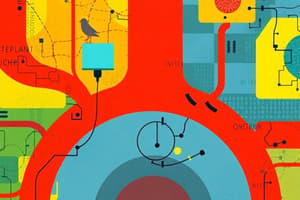Podcast
Questions and Answers
What significant invention did Tim Berners-Lee introduce in 1990?
What significant invention did Tim Berners-Lee introduce in 1990?
- The concept of e-commerce
- The first social media platform
- The graphical user interface (GUI) browser (correct)
- The Internet programming language Java
Which major event in the development of the Internet occurred in 1995?
Which major event in the development of the Internet occurred in 1995?
- The introduction of cloud computing
- The end of National Science Foundation funding for the Internet (correct)
- The founding of Google
- The launch of Facebook
What term became synonymous with the Internet after its introduction in 2006?
What term became synonymous with the Internet after its introduction in 2006?
- Social media
- Wireless technology
- Cloud computing (correct)
- The World Wide Web
What was established in 1994 that significantly changed online commerce?
What was established in 1994 that significantly changed online commerce?
How did the role of the Internet change from 2007 onward?
How did the role of the Internet change from 2007 onward?
What does the term 'Infobahn' refer to?
What does the term 'Infobahn' refer to?
Which year marks the first appearance of the word 'Internet' in print?
Which year marks the first appearance of the word 'Internet' in print?
What significant development occurred in 1983 regarding the Internet?
What significant development occurred in 1983 regarding the Internet?
Charles Leadbeater is known for the quote, 'You are what you share.' What does this imply about online presence?
Charles Leadbeater is known for the quote, 'You are what you share.' What does this imply about online presence?
What does ARPANET refer to?
What does ARPANET refer to?
Which advancement marked the largest upgrade to ARPANET in 1985?
Which advancement marked the largest upgrade to ARPANET in 1985?
What can you infer about the Internet from the description provided?
What can you infer about the Internet from the description provided?
Which of the following activities is INFLUENCED by the Internet as stated in the content?
Which of the following activities is INFLUENCED by the Internet as stated in the content?
What does the acronym URL stand for?
What does the acronym URL stand for?
Which of the following is NOT a fundamental technology of the World Wide Web?
Which of the following is NOT a fundamental technology of the World Wide Web?
What is the role of the protocol in a URL?
What is the role of the protocol in a URL?
Which HTML version is the latest as mentioned in the context?
Which HTML version is the latest as mentioned in the context?
What does the domain name in a URL identify?
What does the domain name in a URL identify?
How are web pages accessed through the World Wide Web?
How are web pages accessed through the World Wide Web?
What is the purpose of Hypertext Transfer Protocol (HTTP)?
What is the purpose of Hypertext Transfer Protocol (HTTP)?
Which component of the URL specifies the name of the file and its directory?
Which component of the URL specifies the name of the file and its directory?
What major development in online communication took place in 2004?
What major development in online communication took place in 2004?
What significant shift occurred in 1995 regarding the funding of the Internet?
What significant shift occurred in 1995 regarding the funding of the Internet?
What technological development occurred in 2006 that became a synonym for the Internet?
What technological development occurred in 2006 that became a synonym for the Internet?
Which of the following statements best describes the development of the Internet as of the present?
Which of the following statements best describes the development of the Internet as of the present?
What was a key outcome of the introduction of mobile and smartphone technologies in 2007?
What was a key outcome of the introduction of mobile and smartphone technologies in 2007?
What is one of the alternative names for the Internet mentioned?
What is one of the alternative names for the Internet mentioned?
Which year saw the first message sent over ARPANET?
Which year saw the first message sent over ARPANET?
What was invented in 1983 that simplified site names?
What was invented in 1983 that simplified site names?
What does the quote by Charles Leadbeater imply about online identity?
What does the quote by Charles Leadbeater imply about online identity?
Which communication protocol remains integral to the Internet since its introduction?
Which communication protocol remains integral to the Internet since its introduction?
Which term was mainly used in the 1990s to describe digital communication systems?
Which term was mainly used in the 1990s to describe digital communication systems?
What was ARPANET's significant upgrade in 1985 funded by the National Science Foundation?
What was ARPANET's significant upgrade in 1985 funded by the National Science Foundation?
What enables sharing information back and forth across computers connected to the Internet?
What enables sharing information back and forth across computers connected to the Internet?
What is the primary function of Hypertext Markup Language (HTML) in the World Wide Web?
What is the primary function of Hypertext Markup Language (HTML) in the World Wide Web?
Which part of a URL provides instructions on how a web browser should communicate with a web server?
Which part of a URL provides instructions on how a web browser should communicate with a web server?
What is the role of the domain name in a URL?
What is the role of the domain name in a URL?
What foundational technology serves as the communication protocol for sending and receiving web pages?
What foundational technology serves as the communication protocol for sending and receiving web pages?
Which of the following defines the unique address of a web page?
Which of the following defines the unique address of a web page?
Which of the following is NOT a part of a URL's structure?
Which of the following is NOT a part of a URL's structure?
What is included in the Resource ID of a URL?
What is included in the Resource ID of a URL?
What does HTML5 represent?
What does HTML5 represent?
Flashcards are hidden until you start studying
Study Notes
The Internet
- The Internet, also called the Net or Infobahn, is a massive network of computers interconnected worldwide.
- It facilitates the sharing of vast amounts of information and data.
- The term "Infobahn" became popular during the 1990s to describe digital communication systems and the Internet's telecommunications network.
- The Internet enables things like sending data through electronic mail.
History of the Internet
- 1969: The first instant message was sent over ARPANET from the University of California, Los Angeles (UCLA) to Stanford University (SRI).
- 1974: The term "Internet" appeared in the Defense Advanced Research Projects Agency (DARPA) for a request for comments on the Transmission Control Protocol/Internet Protocol (TCP/IP) document.
- 1983: The Domain Name System (DNS) was introduced, making site names easier to remember with endings like .gov, .edu, or .mil.
- 1985: The National Science Foundation (NSF) funded the construction of the NSFNET, a significant upgrade of ARPANET, with five supercomputers serving as data traffic hubs.
- 1990: Tim Berners-Lee created HTML, a text browser, and graphical user interface (GUI). He established the first successful communication using the Hypertext Transfer Protocol (HTTP) between a client and server. Berners-Lee also coined the term "World Wide Web."
- 1991: The NSF permitted commercial businesses to use the Internet.
- 1994: Jeff Bezos founded Amazon, marking the birth of e-commerce.
- 1995: The NSF stopped funding the Internet, making it a self-sustaining industry. Sun Microsystems released Java.
- 1998: Google opened its first office.
- 2004-2005: Social media took off with the launch of Facebook followed by YouTube.
- 2006: Google CEO Eric Schmidt introduced "Cloud computing," which quickly became synonymous with the internet.
- 2007: Mobile and smartphone technologies gained popularity, making internet access on the go possible.
- Present: The Internet is becoming increasingly integrated into people's lives, with mobile, wearable, and embedded computing connected through the Internet of Things.
World Wide Web
- The World Wide Web (WWW) or web is an information space accessible through the Internet, containing a collection of interconnected web pages.
- The WWW provides immediate access to millions of web pages, which can include text, colors, sounds, pictures, and videos.
- The web is built on three foundational technologies:
- Hypertext Markup Language (HTML): The language used to create web pages (HTML5 is the latest version).
- Hypertext Transfer Protocol (HTTP): The communication protocol used to send and receive web pages and files on the Internet, forming the basis of data communication for the WWW.
- Uniform Resource Locator (URL): The unique web address used to identify resources on the web. It can be found in the web page's address bar.
- URL Structure
- Protocol: Defines how a web browser should communicate with a web server.
- Domain Name: Identifies the organization responsible for the information.
- Resource ID: The file name for the web page and its associated directories on the specified computer.
What is the Internet?
- The Internet is a global network of computer networks
- It is nicknamed the "Net"
- It allows for mass information sharing due to the interconnectedness of millions of computers
- It is also known as the "Information Superhighway" or "Infobahn"
- The Infobahn was a popular term for the Internet in the 1990s
- It enabled information to travel back and forth between computers linked to the network
History of the Internet
- 1969: The first instant message was sent over ARPANET from UCLA to Stanford University
- 1974: The word "Internet" first appeared in a DARPA publication about the Transmission Control Protocol/Internet Protocol (TCP/IP)
- 1983: The Domain Name System (DNS) was invented
- 1985: The NSFNET, a major upgrade to ARPANET, was funded by the National Science Foundation (NSF)
- 1990: Tim Berners-Lee invented HTML and the first successful communication between HTTP client and server
- 1991: NSF allowed commercial industry to use the Internet
- 1994: Jeff Bezos founded Amazon, launching e-commerce
- 1995: The National Science Foundation stopped funding the Internet, making it a self-sustaining industry
- 1998: Google opened its first office
- 2004-2005: Social media revolution began with Facebook and YouTube
- 2006: Eric Schmidt of Google introduced "cloud computing"
- 2007: Mobile and smartphone technologies went mainstream, enabling wireless Internet access
- Present: The Internet has become essential, with mobile, wearable, and embedded computing being connected through the "Internet of Things"
- The Internet has become increasingly influential, with billions connected via social media, chat, forums, and video conferencing
The World Wide Web
- The World Wide Web (WWW) is a collection of interlinked web pages accessed via the Internet
- It allows millions of web pages to be accessed instantly
- Web pages contain text, colors, sounds, pictures, and videos
- The WWW relies on three core technologies:
- HTML (Hypertext Markup Language): Used to create web pages, with HTML5 being the latest version
- HTTP (Hypertext Transfer Protocol): Communication protocol for sending and receiving web pages and files
- URL (Uniform Resource Locator): Unique web address identifying resources on the web
- URLs have three primary components:
- Protocol: Instructs web browsers on how to communicate with a server, including sending or fetching web pages
- Domain Name: Identifies the organization responsible for the information and the specific web page being searched
- Resource ID: Name of the page file and any directories or subdirectories where it is stored on a specific computer
Studying That Suits You
Use AI to generate personalized quizzes and flashcards to suit your learning preferences.




